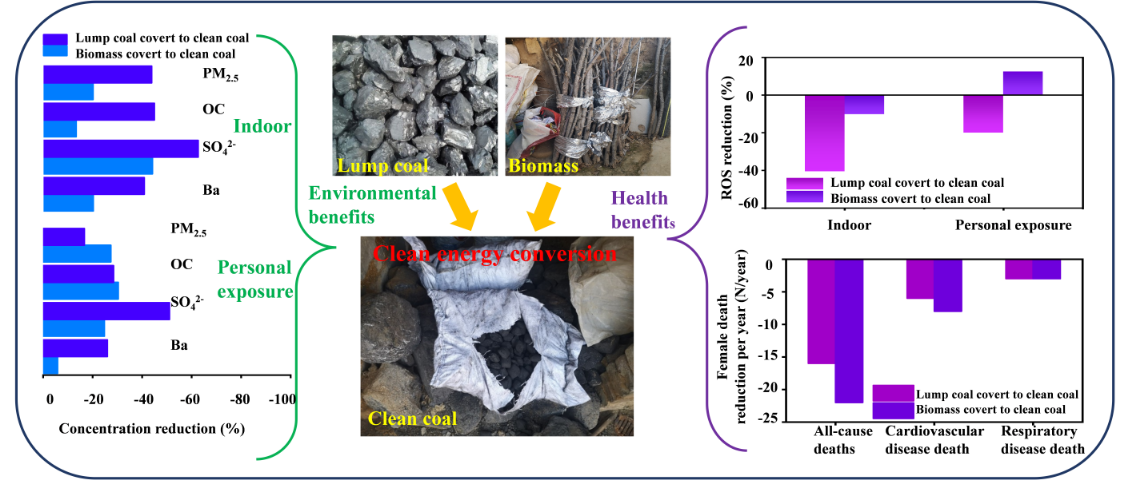To reduce the adverse effects of traditional domestic solid-fuel burning (lump coal and biomass), China’s central government implemented a clean heating policy in northern China in 2017. Clean coal is an alternative short-term, low-cost fuel for some rural households within cities. (In China, city administrative regions are composed of 'urban households' and 'rural households', with the latter being in villages within the city’s jurisdiction).
A joint research team from the Department of Environmental Science and Engineering (Xi’an Jiaotong University), the Institute of Earth Environment (Chinese Academy of Sciences), Hong Kong’s Premium Services and Research Laboratory, and the United States’ Desert Research Institute, conducted a quantitative analysis of the effects of substituting traditional fuels with clean energy in rural households of the city of Tongchuan—a so-called 'energy city' on the Fenwei Plain in central Shaanxi Province, China.
The Fenwei Plain is situated in the middle reaches of the Yellow River and it has been designated as one of the three key regions for air pollution control, replacing the Pearl River Delta region in 2018. In this study, 18 households and homemakers (female family members in charge of the day-to-day running of the home) using clean coal, lump coal, or biomass as their main fuels were selected to evaluate the benefits of transformation to 'clean heating'.
The team found that, compared with the lump-coal and biomass groups, the indoor fine particulate (PM2.5) concentration in the clean-coal group was 43.6% and 20.0% lower, respectively, while the values were 16.8% and 21.3% lower, respectively, in the personal exposure to PM2.5 samples. Replacement with clean coal also showed significant reductions in the chemical components of PM2.5, such as organic carbon, elemental carbon, and barium. Moreover, reactive oxygen species (ROS) were introduced to evaluate the impact of exposure to PM2.5 components from different fuel combustion sources and it was found that cadmium, nickel, zinc, and manganese were key chemical components for the generation of oxidative stress, which were strongly correlated with ROS levels in all fuel groups.
'In addition, we evaluated the health benefits of using clean coal, based on the results of a previous epidemiological study,' explains Dr. Hongmei Xu, the corresponding author of the study, published in Advances in Atmospheric Sciences. According to their assessment, after the substitution of clean coal as a household fuel, the 'all-cause', 'cardiovascular' and 'respiratory' disease groups, in relation to causing female deaths each year, could be reduced by 16%, 6% and 3%, respectively, when lump coal was replaced, and by 22%, 8% and 3%, respectively, when biomass fuel was replaced.
However, on a cautionary note, even though the promotion of clean coal has led to impressive environmental and health benefits, the efficiencies involved are still limited. 'For a long-term environmental conservation plan, cleaner energies such as electric power, natural gas, and solar energy should gradually be applied to complete the replacement of domestic solid fuels in rural regions of China,' the team concluded.

Impacts of clean-energy transformation in rural households on PM2.5 and its environmental and health benefits in the Fenwei Plain region, China
Citation: Wang, Z. X., and Coauthors, 2023: Characteristics of PM2.5 and its reactive oxygen species in heating energy transition and estimation of its impact on the environment and health in China—A case study in the Fenwei Plain. Adv. Atmos. Sci., https://doi.org/10.1007/s00376-022-2249-1
Contact: Li Yang , Institute of Earth Environment, Chinese Academy of Sciences, Xi'an, China. Email: liyang2018@ieecas.cn
 © 2015 Institute of Earth Environment,CAS
© 2015 Institute of Earth Environment,CAS Address:No. 97 Yanxiang Road, Xi'an 710061, Shaanxi, China

 Location :
Location :